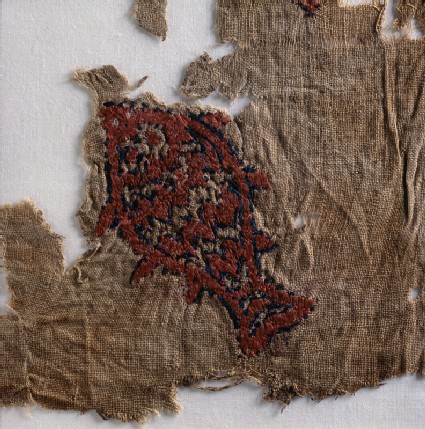Embroideries and Samplers from Islamic Egypt
A selection of 10th to 16th century embroideries from the Newberry collection at the Ashmolean by Marianne Ellis (published Oxford, 2001).

Publications online: 66 objects
- Reference URL
Actions
Textile fragment with fish
-
Literature notes
Fish and bird motifs were popular subjects for embroidery on clothing either in pairs or in offset rows making an all-over pattern. This fish is one of a pair slanting towards the left; above it, not shown in the illustration [in the book], are the remains of another fish slanting towards the right. Although it is a stylised version of a flat fish, it is full of interesting details with its two large round eyes, three pairs of fins and zigzag stripes across its back. Fish motifs were considered lucky and thought to signify continued prosperity. As in Nos.45 [EA1984.76] and 46 [EA1984.63], the embroidery is couched work, but the outlines in blue silk are worked in outline stitch. This is similar to stem stitch except that the thread is kept on the left side of the needle thereby producing a much straighter line. -
Details
- Associated place
-
Near East (place of creation)
- Date
-
late 13th century - 14th century
Mamluk Period (1250 - 1517)
- Material and technique
- linen, embroidered with red and blue silk
- Dimensions
-
ground fabric 18 x 22 cm (warp x weft)
ground fabric 22 / 23 threads/cm (thread count)
ground fabric 0.03 cm (thread diameter)
additional fibre, embroidery 0.06 cm (thread diameter)
- Material index
-
organic › animal › animal product › silk,
- Technique index
-
assembled › woven › plain woven,woven › plain woven,
- Object type index
- No. of items
- 1
- Credit line
- Presented by Professor Percy Newberry, 1941.
- Accession no.
- EA1993.99
-
Further reading
Ellis, Marianne, Embroideries and Samplers from Islamic Egypt (Oxford: Ashmolean Museum, in association with Greenville: Curious Works Press, 2001), no. 47 on p. 68, pp. 69-70, illus. p. 68
Newberry, Essie W., ‘Embroideries from Egypt’, Embroidery: the Journal of the Embroiderers' Guild, (1940), cat. 8, fig.5
Barnes, Ruth and Marianne Ellis, ‘The Newberry Collection of Islamic Embroideries’, 4 vols, 2001, Oxford, Ashmolean Museum, cat. p. 60 (vol. iv), illus. vol. iv p. 60
Location
-
- currently in research collection
Objects are sometimes moved to a different location. Our object location data is usually updated on a monthly basis. Contact the Jameel Study Centre if you are planning to visit the museum to see a particular object on display, or would like to arrange an appointment to see an object in our reserve collections.
Publications online
-

Embroideries and Samplers from Islamic Egypt
Fish and bird motifs were popular subjects for embroidery on clothing either in pairs or in offset rows making an all-over pattern. This fish is one of a pair slanting towards the left; above it, not shown in the illustration [in the book], are the remains of another fish slanting towards the right. Although it is a stylised version of a flat fish, it is full of interesting details with its two large round eyes, three pairs of fins and zigzag stripes across its back. Fish motifs were considered lucky and thought to signify continued prosperity. As in Nos.45 [EA1984.76] and 46 [EA1984.63], the embroidery is couched work, but the outlines in blue silk are worked in outline stitch. This is similar to stem stitch except that the thread is kept on the left side of the needle thereby producing a much straighter line. -

The Newberry Collection of Islamic Embroideries
Two fish and remains of a third, all filled with red chevron lines and blue outlines.
Notice
Object information may not accurately reflect the actual contents of the original publication, since our online objects contain current information held in our collections database. Click on 'buy this publication' to purchase printed versions of our online publications, where available, or contact the Jameel Study Centre to arrange access to books on our collections that are now out of print.
© 2013 University of Oxford - Ashmolean Museum

